1993 DODGE TRUCK brake sensor
[x] Cancel search: brake sensorPage 21 of 1502

0 - 2
LUBRICATION
AND
MAINTENANCE
• Commercial service
When a vehicle is continuously subjected to severe
driving conditions, lubricate:
• Body components
• All the driveline coupling joints
• Steering linkage More often than normal driving conditions
DUSTY
AREAS
With this type of severe driving condition, special
care should be given to the:
• Engine air cleaner filter
• PCV filter
• Crankcase ventilation system
• Brake booster control valve air filter. Verify that the filters and the associated compo
nents are clean. Also verify that they are functioning
effectively. This will minimize the amount of abra sive particles that enter the engine.
OFF-ROAD
(4WD)
OPERATION
After off-road (4WD) operation, inspect the under
side of the vehicle. Inspect the:
• Tires
• Body structure
• Steering components
• Suspension components • Exhaust system
• Threaded fasteners
HARSH
SURFACE ENVIRONMENTS
After extended operation in harsh environments,
the brake drums, brake linings, and rear wheel bear ings should be inspected and cleaned. This will pre
vent wear and erratic brake action.
ROUTINE MAINTENANCE
The following routine maintenance is recommended
on a monthly basis: TIRES—Inspect the tires for unusual wear/damage.
Determine if the inflation pressure is adequate for
the vehicle load. BATTERY—Inspect and clean the terminals.
Tighten the terminals if necessary. FLUIDS—Determine if the component fluid levels
are acceptable. Add fluid, if necessary. LIGHTS/ELECTRICAL—Test all the electrical sys
tems in the vehicle for proper operation. It is also recommended that the engine oil and the
washer fluid level be determined at each fuel fill-up.
VEHICLE
NOISE CONTROL
Vehicles with a GVWR of 4 535 kg (10,000 lbs), or
more, are required to comply with Federal Exterior Noise Regulations (Fig. 2).
VEHICLE
NOISE
EMISSION
CONTROL INFORMATION
DATE
OF
VEHICLE
MANUFACTURE
THIS
VEHICLE CONFORMS
TO
U.S. EPA REGULATIONS FOR NOISE EMISSION
APPLICABLE
TO
MEDIUM
AND HEAVY
DUTY
TRUCKS. THE
FOLLOWING
ACTS OR THE CAUSING THEREOF BY ANY PERSON ARE PROHIBITED BY THE NOISE CONTROL ACT
OF 1972. (A) THE
REMOVAL
OR
RENDERING
INOPERATIVE, OTHER
THAN
FOR
PURPOSES
OF
MAINTENANCE,
REPAIR.
OR REPLACEMENT, OF ANY NOISE CONTROL DEVICE OR ELEMENT OF
DESIGN
(LISTED
IN
THE
OWNERS
MANUAL)
INCORPORATED
INTO
THIS
VEHICLE
IN COMPLIANCE
WITH
THE NOISE CONTROL
ACT:
(B) THE
USE
OF
THIS
VEHICLE
AFTER SUCH DEVICE
OR
ELEMENT
OF
DESIGN HAS BEEN REMOVED
OR
RENDERED
INOPERATIVE.
PU626D
Fig.
2 Vehicle
Noise
Emission
Control Information
Label
UNAUTHORIZED
DEFEAT
OF
NOISE
CONTROL COMPONENTS
Federal law prohibits removal, altering or other
wise defeating any noise control component. This in
cludes before or after the vehicle is in use. Federal
law also prohibits the use of a vehicle after a noise
control component is defeated.
REQUIRED MAINTENANCE/SERVICE
FOR
NOISE
CONTROL
The following maintenance is required after each
6-month or 9 600 km (6,000 miles) interval. This will
ensure that the vehicle noise control components are
operating properly.
EXHAUST SYSTEM
Inspect exhaust system for exhaust leaks and dam
aged components. The exhaust hangers, clamps and
U-bolts should be attached and in good condition.
Burned or ruptured mufflers, damaged exhaust pipes should be replaced. Refer to Group 11—Exhaust Sys
tem/Intake Manifold for service information.
AIR
FILTER
HOUSING/CANISTER
Inspect the air filter assembly for proper fit. Verify
the cover is securely attached to the housing/canis
ter. Inspect all the air filter housing hoses for con nections. The gasket between the air filter housing and throttle body must be in good condition. The air
filter element should be clean and serviced according
to the maintenance schedule.
FUEL
REQUIREMENTS
GASOLINE
ENGINES
All engines require the use of unleaded gasoline to
reduce the effects of lead to the environment. Also unleaded fuel is necessary to prevent damage to the
catalytic converter/02 sensor. The fuel must have a
minimum octane rating of 87 based on the (R + M)/2
calculation method.
Page 130 of 1502
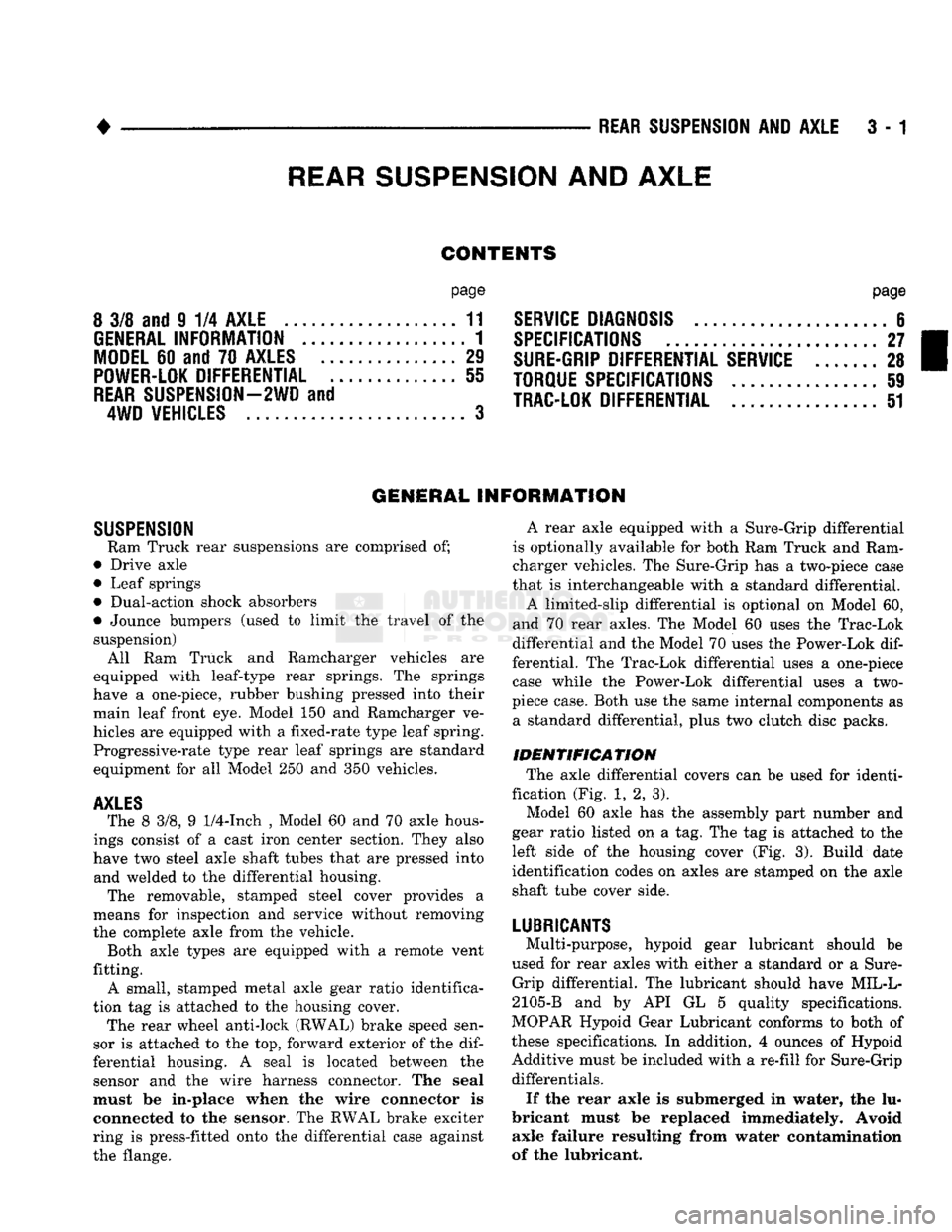
•
REAR
SUSPENSION
AND
AXLE
3 - 1
CONTENTS
page
8
3/8 and 9 1/4
AXLE
11
GENERAL
INFORMATION
1
MODEL
60 and 70
AXLES
29
POWER-LOK DIFFERENTIAL
55
REAR
SUSPENSION—2WD
and
4WD VEHICLES
3
page
SERVICE
DIAGNOSIS
6
SPECIFICATIONS
27
SURE-GRIP
DIFFERENTIAL SERVICE
28
TORQUE SPECIFICATIONS
59
TRAC-LOK DIFFERENTIAL
51
GENERAL INFORMATION
SUSPENSION
Ram Truck rear suspensions
are
comprised
of;
• Drive axle
• Leaf springs
• Dual-action shock absorbers
• Jounce bumpers (used
to
limit
the
travel
of the
suspension) All
Ram
Truck
and
Ramcharger vehicles
are
equipped with leaf-type rear springs.
The
springs
have
a
one-piece, rubber bushing pressed into their main leaf front
eye.
Model
150 and
Ramcharger
ve
hicles
are
equipped with
a
fixed-rate type leaf spring. Progressive-rate type rear leaf springs
are
standard equipment
for all
Model
250 and 350
vehicles.
AXLES
The
8 3/8, 9
1/4-Inch
,
Model
60 and 70
axle hous
ings consist
of a
cast iron center section. They also
have
two
steel axle shaft tubes that
are
pressed into and welded
to the
differential housing. The removable, stamped steel cover provides
a
means
for
inspection
and
service without removing
the complete axle from
the
vehicle. Both axle types
are
equipped with
a
remote vent
fitting. A small, stamped metal axle gear ratio identifica
tion
tag is
attached
to the
housing cover. The rear wheel anti-lock (RWAL) brake speed sen
sor
is
attached
to the top,
forward exterior
of the dif
ferential housing.
A
seal
is
located between
the
sensor
and the
wire harness connector.
The
seal
must
be
in-plaee when
the
wire connector
is
connected
to the
sensor.
The
RWAL brake exciter
ring
is
press-fitted onto
the
differential case against
the flange. A rear axle equipped with
a
Sure-Grip differential
is optionally available
for
both
Ram
Truck
and
Ram
charger vehicles.
The
Sure-Grip
has a
two-piece case
that
is
interchangeable with
a
standard differential.
A limited-slip differential
is
optional
on
Model
60,
and
70
rear axles.
The
Model
60
uses
the
Trac-Lok
differential
and the
Model
70
uses
the
Power-Lok
dif
ferential.
The
Trac-Lok differential uses
a
one-piece case while
the
Power-Lok differential uses
a two-
piece case. Both
use the
same internal components
as
a standard differential, plus
two
clutch disc packs.
IDENTIFICATION The axle differential covers
can be
used
for
identi
fication (Fig.
1, 2, 3).
Model
60
axle
has the
assembly part number
and
gear ratio listed
on a tag. The tag is
attached
to the
left side
of the
housing cover
(Fig. 3).
Build date
identification codes
on
axles
are
stamped
on the
axle
shaft tube cover side.
LUBRICANTS
Multi-purpose, hypoid gear lubricant should
be
used
for
rear axles with either
a
standard
or a
Sure- Grip differential.
The
lubricant should have MIL-L-
2105-B
and by API GL 5
quality specifications.
MOPAR Hypoid Gear Lubricant conforms
to
both
of
these specifications.
In
addition,
4
ounces
of
Hypoid Additive must
be
included with
a
re-fill
for
Sure-Grip differentials.
If
the
rear axle
is
submerged
in
water,
the lu
bricant must
be
replaced immediately. Avoid axle failure resulting from water contamination
of
the
lubricant.
REAR
SUSPENSION
AND
AXLE
Page 152 of 1502
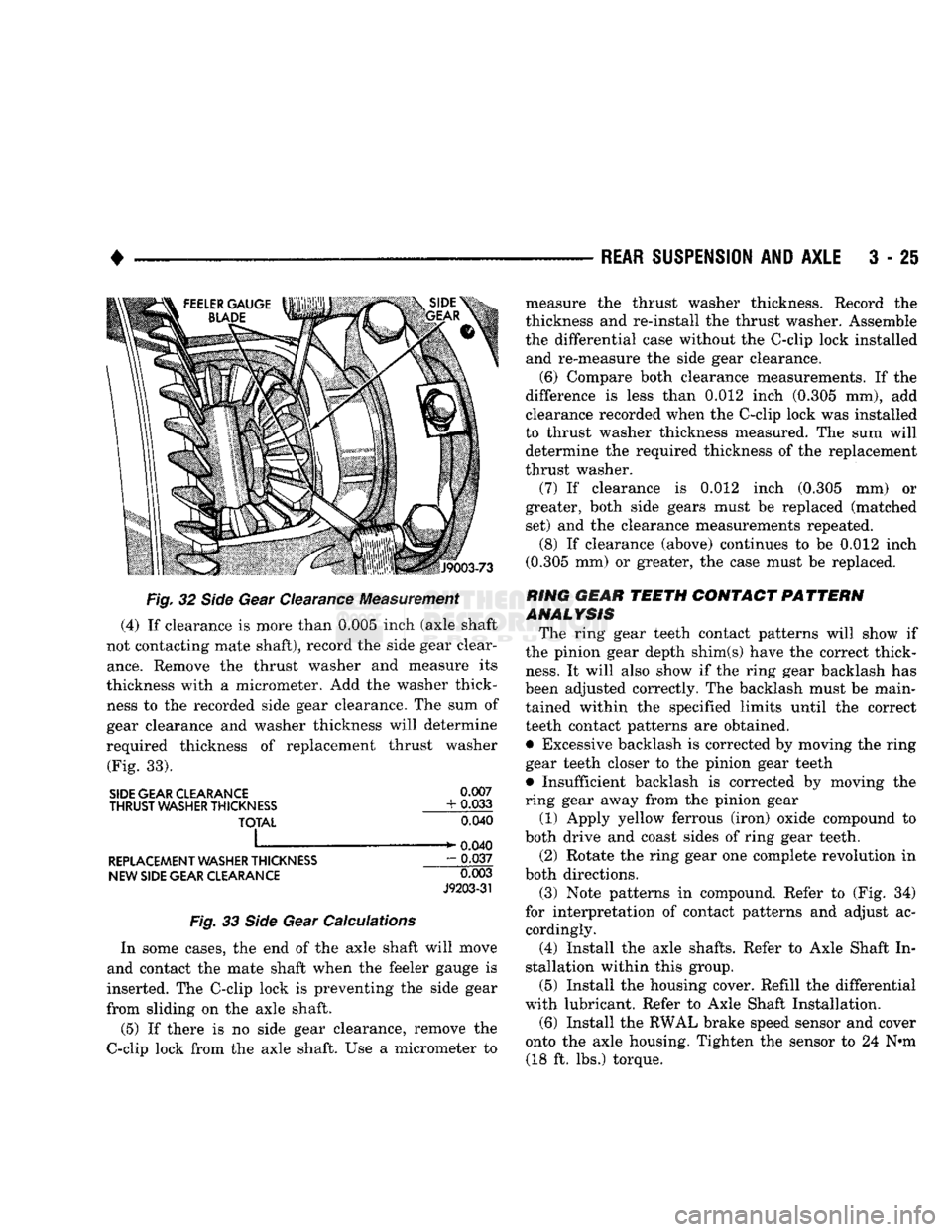
REAR
SUSPENSION
AND
AXLE
3 - 2§
Fig.
32
Side
Gear Clearance Measurement
(4)
If
clearance
is
more than 0.005 inch (axle shaft
not contacting mate shaft), record
the
side gear clear
ance.
Remove
the
thrust washer
and
measure
its
thickness with
a
micrometer.
Add the
washer thick ness
to the
recorded side gear clearance.
The sum of
gear clearance
and
washer thickness will determine
required thickness
of
replacement thrust washer (Fig.
33).
SIDE GEAR CLEARANCE
0.007
THRUST
WASHER THICKNESS
+ 0.033
TOTAL
0.040
I ^ ^ 0.040
REPLACEMENT WASHER THICKNESS
- 0.037
NEW SIDE GEAR CLEARANCE
0.003
J9203-31
Fig.
33
Side
Gear Calculations
In some cases,
the end of the
axle shaft will move
and contact
the
mate shaft when
the
feeler gauge
is
inserted.
The
C-clip lock
is
preventing
the
side gear
from sliding
on the
axle shaft.
(5)
If
there
is no
side gear clearance, remove
the
C-clip lock from
the
axle shaft.
Use a
micrometer
to
measure
the
thrust washer thickness. Record
the
thickness
and
re-install
the
thrust washer. Assemble
the differential case without
the
C-clip lock installed and re-measure
the
side gear clearance.
(6) Compare both clearance measurements.
If the
difference
is
less than
0,012
inch (0.305
mm), add
clearance recorded when
the
C-clip lock
was
installed
to thrust washer thickness measured.
The sum
will determine
the
required thickness
of the
replacement
thrust washer.
(7)
If
clearance
is 0.012
inch (0.305
mm) or
greater, both side gears must
be
replaced (matched set)
and the
clearance measurements repeated.
(8)
If
clearance (above) continues
to be 0.012
inch
(0.305
mm) or
greater,
the
case must
be
replaced.
RING
GEAR
TEETH CONTACT PATTERN
ANALYSIS
The ring gear teeth contact patterns will show
if
the pinion gear depth shim(s) have
the
correct thick
ness.
It
will also show
if the
ring gear backlash
has
been adjusted correctly.
The
backlash must
be
main tained within
the
specified limits until
the
correct
teeth contact patterns
are
obtained.
• Excessive backlash
is
corrected
by
moving
the
ring gear teeth closer
to the
pinion gear teeth
• Insufficient backlash
is
corrected
by
moving
the
ring gear away from
the
pinion gear
(1) Apply yellow ferrous (iron) oxide compound
to
both drive
and
coast sides
of
ring gear teeth. (2) Rotate
the
ring gear
one
complete revolution
in
both directions.
(3) Note patterns
in
compound. Refer
to (Fig. 34)
for interpretation
of
contact patterns
and
adjust
ac
cordingly.
(4) Install
the
axle shafts. Refer
to
Axle Shaft
In
stallation within this group. (5) Install
the
housing cover. Refill
the
differential
with lubricant. Refer
to
Axle Shaft Installation.
(6) Install
the
RWAL brake speed sensor
and
cover
onto
the
axle housing. Tighten
the
sensor
to 24 N*m
(18
ft. lbs.)
torque.
Page 154 of 1502

•
REAR
SUSPENSION
AND
AXLE
3 - 27
SPECIFICATIONS
8
1/4
INCH AXLE
Axle Type .Semi-floating, hypoid
Ring Gear Diam.. ....8.25
in.
(20.95 cm)
Lubricant............................. .........SAE 80W-90
Lube Capacity.....
70
oz. (2.08
L)
Sure-Grip Additive ....4 oz. (118
ml)
Diff.
Case Clearance.. 0.005
in.
(0.12 mm)
Ring Gear Backlash.0.005-0.008
in.
(0.12-0.20 mm)
Pinion Bearing Preload........ 10-20 in.lbs. (1-2 N*m) Case Flange Runout ................0.003
in.
(0.076 mm)
Ring Gear Runout ....0.005
in.
(0.127 mm)
AXLE
RATIOm„...,„GEAR/TEETH COMBINATION
3.55:1.....
39/11
3.90:1............
...............39/10
9
1/4
INCH AXLE
Axle Type .............Semi-floating, hypoid
Ring Gear Diam 9.25
in.
(23.50 cm)
Lubricant ....................SAE 80W-90
Lube Capacity ........76 oz. (2.26
L)
Diff.
Case Clearance 0.005
in.
(0.12 mm)
Ring Gear Backlash.0.005-0.008
in,
(0.12-0.20 mm)
Pinion Bearing Preload. 10-20 in.lbs. (1-2 Nnn) Case Flange Runout ................0.003
in.
(0.076 mm)
Ring Gear Runout..... .......0.005
in.
(0.127 mm)
AXLE
RATIO ........GEAR/TEETH COMBINATION
3.55:1.
.......39/11
3.90:1..............
39/10
TORQUE SPECIFICATIONS
8
1/4 AND 9 1/4
INCH
REAR AXLE
DESCRIPTION
TORQUE
8-3/8
Axle
Differential
Bearing Cap Bolt
9-1/4
Axle
Differential
Bearing Cap Bolt
Brake Backing
Plate
Differential
Housing
Cover
Bolt....
Pinion Yoke Nut (Minimum
Torque)
Ring
Gear Bolt
RWAL
Brake
Sensor...........
95 N*m (70 ft.
lbs.)
136 N»m(100ft.
lbs.!
... 64
N*m (48 ft. lbs.]
47
N»m
(35 ft.
lbs.)
285 N*m
(21
Oft. lbs.)
... 95
N*m (70 ft. lbs.)
... 24
N*m (18 ft.
lbs.)
J9203-69
Page 161 of 1502
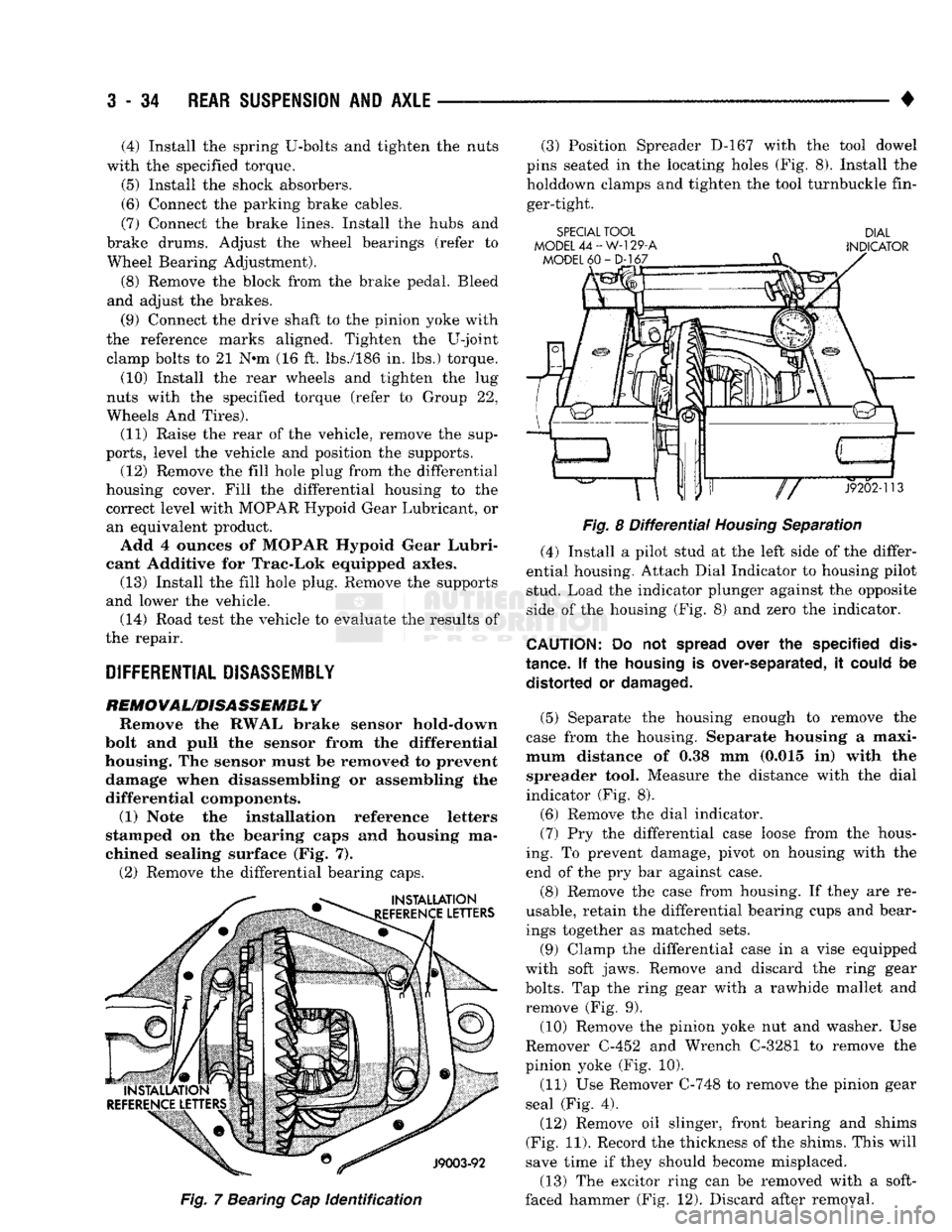
3
- 34
REAR SUSPENSION
AND
AXLE
• (4) Install the spring U-bolts and tighten the nuts
with the specified torque.
(5) Install the shock absorbers.
(6) Connect the parking brake cables.
(7) Connect the brake lines. Install the hubs and
brake drums. Adjust the wheel bearings (refer to Wheel Bearing Adjustment).
(8) Remove the block from the brake pedal. Bleed
and adjust the brakes.
(9) Connect the drive shaft to the pinion yoke with
the reference marks aligned. Tighten the U-joint clamp bolts to 21 N-m (16 ft. lbs./186 in. lbs.) torque.
(10) Install the rear wheels and tighten the lug
nuts with the specified torque (refer to Group 22,
Wheels And Tires). (11) Raise the rear of the vehicle, remove the sup
ports,
level the vehicle and position the supports. (12) Remove the fill hole plug from the differential
housing cover. Fill the differential housing to the correct level with MOPAR Hypoid Gear Lubricant, or
an equivalent product. Add 4 ounces of MOPAR Hypoid Gear Lubri
cant Additive for Trac-Lok equipped axles. (13) Install the fill hole plug. Remove the supports
and lower the vehicle. (14) Road test the vehicle to evaluate the results of
the repair.
DIFFERENTIAL
DISASSEMBLY
RE MO VA
L/DISA
SSEMBL Y
Remove the RWAL brake sensor
hold-down
bolt and pull the sensor from the differential
housing. The sensor must be removed to prevent damage when disassembling or assembling the differential components.
(1) Note the installation reference letters
stamped on the bearing caps and housing ma
chined sealing surface (Fig. 7). (2) Remove the differential bearing caps.
Fig.
7 Bearing Cap
identification
(3) Position Spreader D-167 with the tool dowel
pins seated in the locating holes (Fig. 8). Install the holddown clamps and tighten the tool turnbuckle fin
ger-tight.
SPECIAL TOOL DIAL
MODEL
44-W-129-A
INDICATOR
Fig.
8
Differential
Housing
Separation
(4) Install a pilot stud at the left side of the differ
ential housing. Attach Dial Indicator to housing pilot
stud. Load the indicator plunger against the opposite
side of the housing (Fig. 8) and zero the indicator.
CAUTION:
Do not
spread
over the specified
dis
tance. If the
housing
is over-separated, it
could
be distorted or
damaged.
(5) Separate the housing enough to remove the
case from the housing. Separate housing a maxi
mum distance of 0.38 mm (0.015 in) with the spreader tool. Measure the distance with the dial
indicator (Fig. 8).
(6) Remove the dial indicator. (7) Pry the differential case loose from the hous
ing. To prevent damage, pivot on housing with the
end of the pry bar against case.
(8) Remove the case from housing. If they are re
usable, retain the differential bearing cups and bear ings together as matched sets.
(9) Clamp the differential case in a vise equipped
with soft jaws. Remove and discard the ring gear
bolts.
Tap the ring gear with a rawhide mallet and
remove (Fig. 9).
(10) Remove the pinion yoke nut and washer. Use
Remover C-452 and Wrench C-3281 to remove the
pinion yoke (Fig. 10).
(11) Use Remover C-748 to remove the pinion gear
seal (Fig. 4).
(12) Remove oil slinger, front bearing and shims
(Fig. 11). Record the thickness of the shims. This will
save time if they should become misplaced.
(13) The excitor ring can be removed with a soft-
faced hammer (Fig. 12). Discard after removal.
Page 177 of 1502
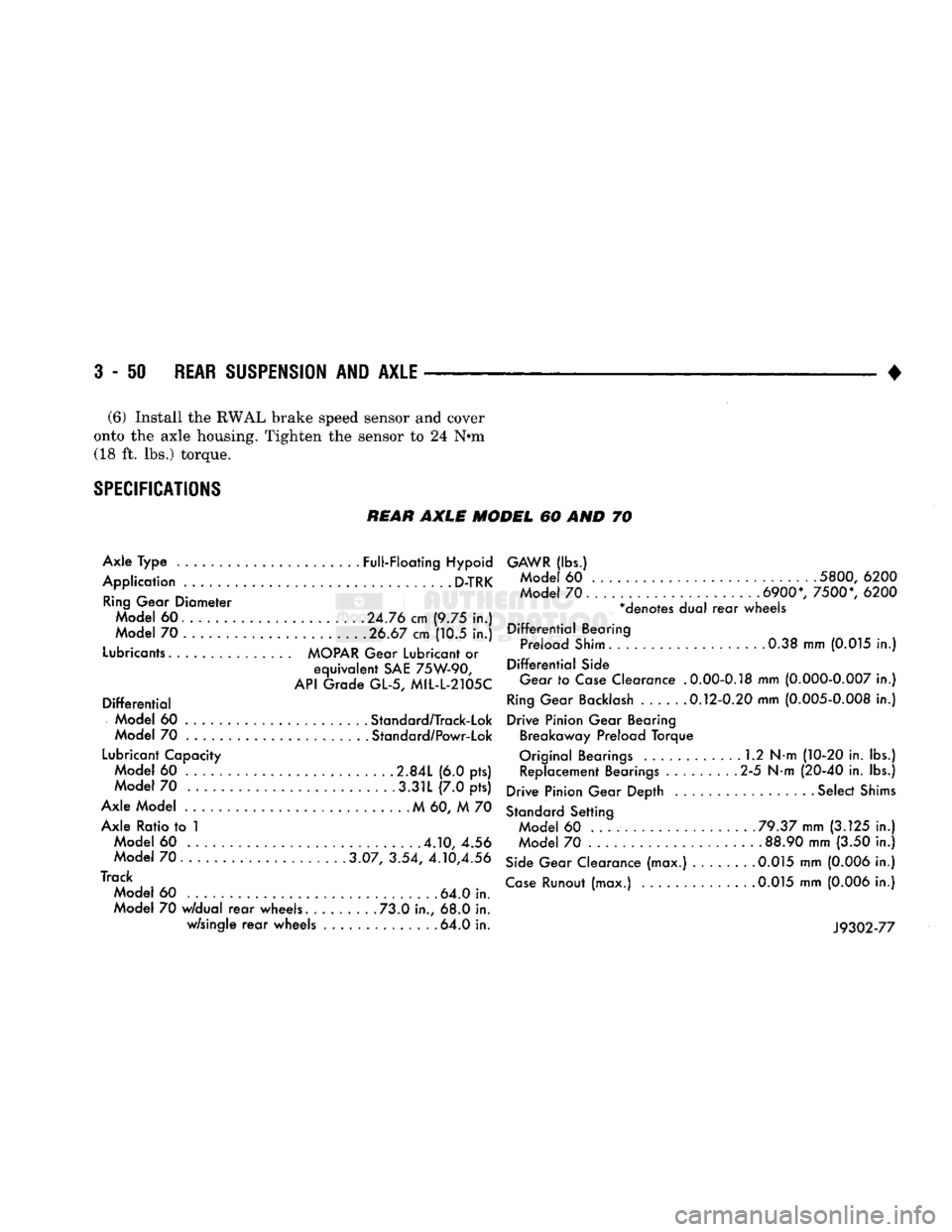
3
- 50
REAR
SUSPENSION
AND
AXLE
• (6)
Install
the
RWAL brake
speed
sensor
and
cover
onto
the
axle
housing.
Tighten
the
sensor
to 24 Nsm (18 ft. lbs.)
torque.
SPECIFICATIONS
REAR
AXLE MODEL 60 AND 70
Axle Type ......................
Full-Floating
Hypoid
Application
D-TRK
Ring
Gear Diameter Model 60. ............ .
.24.76
cm (9.75 in.)
Model 70 .................... .
.26.67
cm (10.5 in.)
Lubricants
MOPAR
Gear
Lubricant
or
equivalent
SAE
75W-90,
API
Grade GL-5, MIL-L-2105C
Differential
Model 60 .... . Standard/Track-Lok
Model 70 Standard/Powr-Lok
Lubricant
Capacity Model 60 .....
2.84L
(6.0 pts) Model 70 .3.31L (7.0 pts)
Axle Model M 60, M 70 Axle Ratio to 1 Model 60
.4.10,
4.56
Model
70......
3.07, 3.54,
4.10,4.56
Track Model 60 . 64.0 in.
Model 70
w/dual
rear
wheels. ....... .73.0 in., 68.0 in. w/single
rear
wheels ............. .64.0 in.
GAWR
(lbs.)
Mode
60
5800,
6200
Mode
70.
6900*,
7500*,
6200
*denotes dual
rear
wheels
Differential
Bearing Preload
Shim.
0.38 mm
(0.015
in.)
Differential
Side
Gear
to
Case
Clearance
.0.00-0.18
mm
(0.000-0.007
in.)
Ring
Gear
Backlash
.....
.0.12-0.20
mm
(0.005-0.008
in.)
Drive Pinion Gear Bearing Breakaway Preload Torque
Original Bearings 1.2 N-m
(10-20
in. lbs.) Replacement Bearings 2-5 N-m
(20-40
in. lbs.)
Drive Pinion Gear Depth ................. Select
Shims
Standard
Setting Model 60 ...
.79.37
mm
(3.125
in.)
Model 70 .
88.90
mm (3.50 in.)
Side
Gear Clearance (max.) 0.015 mm
(0.006
in.)
Case
Runout (max.)
.0.015
mm
(0.006
in.)
J9302-77
Page 186 of 1502
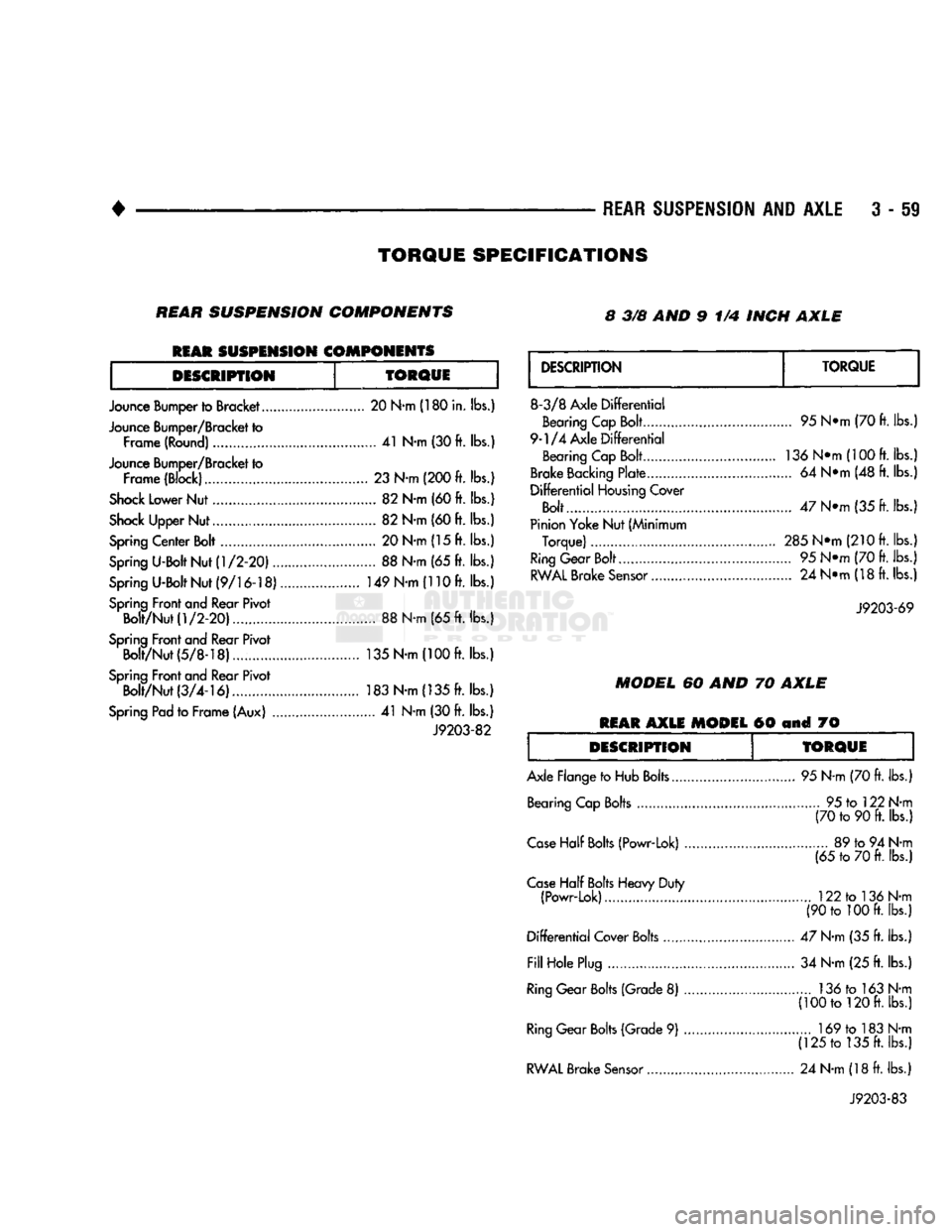
REAR
SUSPENSION
AND
AXLE
3 - 59
TORQUE
SPECIFICATIONS
REAR
SUSPENSION
COMPONENTS 8 3/8 AND 9 1/4 INCH
AXLE
REAR
SUSPENSION
COMPONENTS
DESCRIPTION
TORQUE
Jounce Bumper to Bracket 20 N-m (180 in. lbs.)
Jounce Bumper/Bracket to Frame (Round) 41 N-m (30 ft. lbs.)
Jounce Bumper/Bracket to Frame (Block)......... 23 N-m (200 ft. lbs.)
Shock
Lower Nut 82 N-m (60 ft. lbs.)
Shock
Upper Nut 82 N-m (60 ft. lbs.)
Spring
Center Bolt 20 N-m (15 ft. lbs.)
Spring
U-Bolt Nut
(1/2-20)
88 N-m (65 ft. lbs.)
Spring
U-Bolt Nut
(9/16-18)
149 N-m (110 ft. lbs.)
Spring
Front and Rear Pivot Bolt/Nut
(1/2-20)
88 N-m (65 ft. lbs.)
Spring
Front and Rear Pivot Bolt/Nut(5/8-18).... 135 N-m
(100ft.
lbs.)
Spring
Front and Rear Pivot Bolt/Nut
(3/4-16)
183 N-m (135 ft. lbs.)
Spring
Pad to Frame (Aux) 41 N-m (30 ft. lbs.)
J9203-82
DESCRIPTION
TORQUE
8-3/8 Axle
Differential
Bearing Cap Bolt
9-1/4 Axle
Differential
Bearing Cap Bolt
Brake
Backing
Plate ,
Differential
Housing
Cover
Bolt
Pinion Yoke Nut (Minimum Torque)
Ring
Gear Bolt...
RWAL
Brake
Sensor
95 N*m (70 ft. lbs.)
136
N*m(100
ft. lbs.)
... 64 N*m (48 ft. lbs.)
47 N*m (35 ft. lbs.;
285Ntti
(210 ft. lbs.)
... 95 N*m (70 ft. lbs.) ... 24 N*m (18 ft. lbs.)
J9203-69
MODEL
60 AND 70
AXLE
REAR
AXLE
MODEL
60 and 70
DESCRIPTION
TORQUE
Axle Flange to Hub Bolts. Bearing Cap Bolts 95 N-m (70 ft. lbs.)
... 95 to 122 N-m (70 to 90 ft. lbs.)
Case
Half
Bolts
(Powr-Lok) ..
Case
Half
Bolts
Heavy Duty (Powr-Lok)
Differential
Cover Bolts
Fill
Hole Plug
Ring
Gear
Bolts
(Grade 8)
Ring
Gear
Bolts
(Grade 9)
RWAL
Brake
Sensor
89 to 94 N-m
(65 to 70 ft. lbs.)
122 to 136 N-m
(90 to 100 ft. lbs.)
47 N-m (35 ft. lbs.) 34 N-m (25 ft. lbs.) 136 to 163 N-m
(100 to 120 ft. lbs.) 169 to 183 N-m
(125 to 135 ft. lbs.)
24 N-m (18 ft. lbs.)
J9203-83
Page 204 of 1502
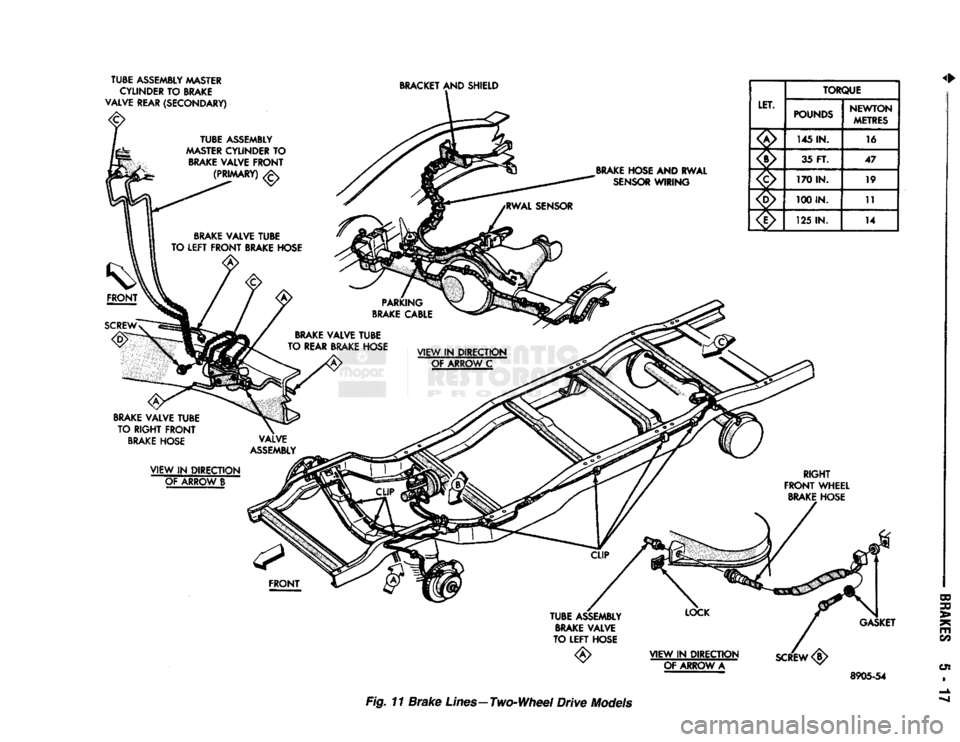
TUBE ASSEMBLY MASTER
CYLINDER TO BRAKE
VALVE REAR (SECONDARY)
BRACKET
AND SHIELD
BRAKE
HOSE AND RWAL
SENSOR
WIRING LET.
TORQUE
LET. POUNDS NEWTON
METRES
x!^ 145 IN.
16
XX 35 FT.
47
170 IN. 19
100 IN.
11
125
IN.
14
BRAKE
VALVE TUBE
TO RIGHT FRONT
BRAKE
HOSE
VIEW IN DIRECTION OF ARROW A
SCREW
<§>
GASKET
8905-54
Fig. 11
Brake
Lines—Two-Wheel
Drive
Models